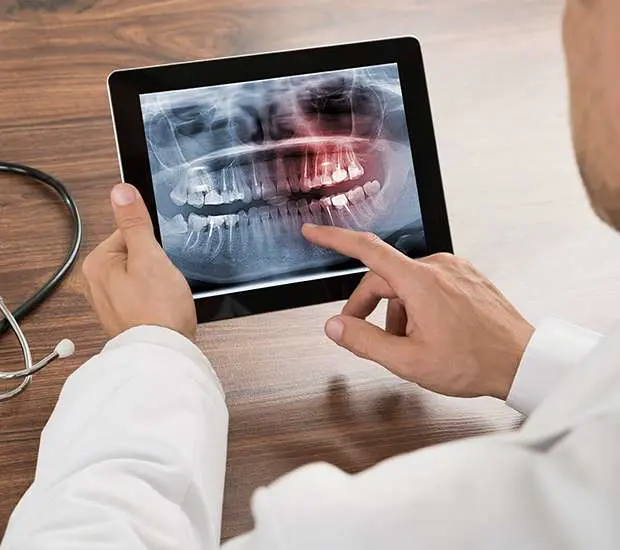Contrary to what some people may assume, there are multiple types of fractures for the roots of teeth. The part of the teeth that people brush and use to chew food or speak is known as the crown. The crown consists of the outer shell known as the enamel and is what most people refer to when they mention anything about the teeth. However, the teeth have roots that actually go deeper into the gums and jawbone. Contact us at Impressions Dental to find out the different types of root fractures there are.
Understanding the Layers of Teeth
Within the tooth, there are layers that people may not be aware of. Underneath the enamel is the dentin. The dentin is the second layer of the tooth and contains the dental pulp. The dental pulp is the center of a tooth and contains the nerves and blood vessels. Any damage to the tooth that effects the position of these layers or reaches the dental pulp will cause the patient serious pain.
Even a minor crack that one decides to leave untreated can lead to catastrophic results the longer the patient waits to seek professional treatment. While a general dentist is certainly effective in preventing infection and keeping teeth healthy, there are issues that only a specialist will be able to treat. An endodontist can provide the necessary treatment for a variety of infections, cracks, chips or breaks in the teeth.
Several different types of tooth fractures
When a tooth fracture goes deep enough, it can jeopardize the entire tooth and the health of the surrounding teeth. The fracture can also allow plaque to breach the layers of the tooth and cause an infection. While the enamel is a shield that protects teeth against infection, a fracture can cause enough damage for the infection to break through.
There are several different types of fractures that an endodontist will treat:
- Oblique supragingival fracture
- An oblique supragingival fracture consists of a crack in the upper portion of the tooth that is above the gum line. This type of fracture may not cause immediate pain, but can lead to infection or pain in the future without treatment. While this type of fracture can be fairly small, it usually affects the surface of the tooth.
- The surface of the tooth is the most-used section for chewing food. Using a tooth with this type of fracture will only cause more issues. With various forms of treatment available, an endodontist will need to examine the fracture in order to determine the most effective form of treatment.
- Oblique subgingival fracture
- An oblique subgingival fracture consists of a fracture that covers more of the tooth and can even reach down the root to the jawbone below the gum line. This type of fracture can cause intense pain and make simple tasks such as chewing, speaking, or even just sitting still, difficult. This type of fracture can also affect the nerves within the tooth.
- Oblique root fracture
- While having a similar title to the other fractures listed above, an oblique root fracture takes place below the gum line and can extend all the way into the jaw. Unlike more minor fractures, this fracture will be extremely painful and will require professional endodontic treatment.
- Vertical furcation fracture
- A vertical furcation fracture involves the tooth splitting and becoming two or more roots. This fracture will cause the patient pain and make it impossible to effectively use the tooth for basic functions.
- Vertical apical root fracture
- A vertical apical root fracture is a fracture directly down the middle of the tooth and root. This type of fracture can be painful and will require professional treatment. In some cases, the treatment may involve a root canal therapy to help the patient heal.
- Vertical root fracture
- If part of the tooth root breaks off, it is known as a vertical root fracture. The cause will often involve brittle roots due to nerve death in the tooth. In other cases, a previous root canal procedure that went wrong can also cause this type of fracture.
Definition of Endodontic Terminology
Cementum Cementum is that bone-like tissue that forms the outer surface on the root of the tooth.
Dental Pulp Dental pulp is the inner-most layer of the tooth with connective tissue that contains blood vessels and nerve tissue.
Dentin Dentin is the inner layer of the tooth structure that is immediately under the enamel and surrounds the dental pulp.
Direct Pulp Cap A direct pulp cap is a procedure in which a professional treats exposed pulp with a therapeutic material to help the tooth heal.
Enamel The enamel is the hard calcified layer that covers the entire tooth and is subject to interaction with multiple substances.
Endodontist An endodontist is a specialist who focuses on treating issues, diseases and conditions that affect the inner-most layer of the tooth, the dental pulp.
Pulpectomy A pulpectomy is a procedure that involves the complete removal of pulp tissue from the root canal in a tooth.
Pulpitis Pulpitis is another term to describe the inflammation of the dental pulp due to an injury or infection.
Pulpotomy A pulpotomy is a procedure involving the removal of a portion of diseased or infected pulp in order to protect the healthy portions of the pulp and teeth still in the mouth.
Helpful Related Links
- American Dental Association (ADA). Glossary of Dental Terms. 2015
- American Academy of Cosmetic Dentistry® (AACD). Home Page. 2015
- WebMD. WebMD’s Oral Care Guide. 2015
About our business, license, and website security
- Impressions Dental was established in 2005.
- We accept the following payment methods: American Express, Cash, Check, Discover, MasterCard, and Visa
- We serve patients from the following counties: Maricopa County
- We serve patients from the following cities: Chandler
- Norton Safe Web. View Details
- Trend Micro Site Safety Center. View Details

